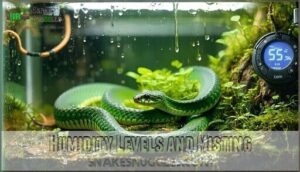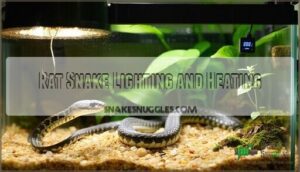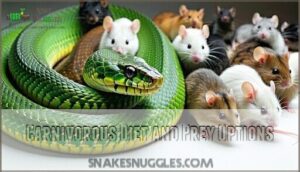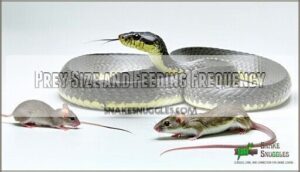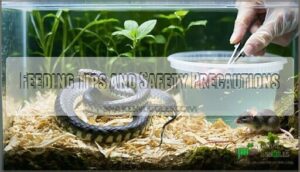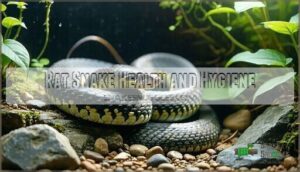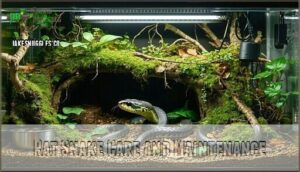This site is supported by our readers. We may earn a commission, at no cost to you, if you purchase through links.
 Rat snakes as pets offer an ideal entry point into reptile ownership. You’ll find them remarkably docile and easy to handle, earning their nickname as the "golden retrievers of snakes." They rarely bite and tolerate regular interaction well.
Rat snakes as pets offer an ideal entry point into reptile ownership. You’ll find them remarkably docile and easy to handle, earning their nickname as the "golden retrievers of snakes." They rarely bite and tolerate regular interaction well.
These constrictors live 15-25 years, requiring a 40-gallon enclosure with proper heating and humidity. You’ll feed them frozen-thawed mice every 10-14 days for adults.
They’re hardy animals with straightforward care needs, making them perfect for beginners who want an exotic pet without complex requirements. Their predictable behavior and manageable size create a rewarding ownership experience that builds confidence with reptile care fundamentals.
Table Of Contents
- Key Takeaways
- Choosing The Right Rat Snake
- Setting Up a Rat Snake Enclosure
- Rat Snake Lighting and Heating
- Feeding Your Pet Rat Snake
- Rat Snake Health and Hygiene
- Handling and Socializing Your Rat Snake
- Rat Snake Behavior and Life Cycle
- Rat Snake Care and Maintenance
- Frequently Asked Questions (FAQs)
- Will a rat snake bite you?
- How long do pet rat snakes live?
- Can rat snakes be aggressive?
- Are rat snakes good to have around?
- Are rat snakes good for beginners?
- Can rat snakes be kept together?
- How often do rat snakes need to be fed?
- Do rat snakes need UVB lighting?
- What is the average lifespan of a pet rat snake?
- Can rat snakes live with other snakes together?
- Conclusion
Key Takeaways
- You’ll get a low-maintenance pet – Rat snakes only need feeding every 10-14 days as adults and rarely bite, making them perfect for beginners who want an exotic pet without daily care demands.
- You’re committing to 15-25 years – These hardy snakes live decades in captivity, so you’ll need to plan for long-term responsibility, including housing, food costs, and veterinary care throughout their lifespan.
- You’ll need a proper 40-gallon setup – Your snake requires a temperature gradient of 88-92°F basking spot to 70-75°F cool side, plus 40-60% humidity and secure hiding spots on both ends.
- You’ll build confidence with reptile care – Their docile temperament and straightforward care requirements make rat snakes ideal for learning proper handling techniques and reptile husbandry fundamentals.
Choosing The Right Rat Snake
Selecting the right rat snake starts with understanding your experience level and commitment to long-term care. You’ll need to choose between different species and morphs while finding a reputable breeder or pet store.
Factors to Consider Before Buying
Before bringing a rat snake home, consider your space commitment and legal restrictions in your area. Assess your owner experience level with reptiles. Check for family allergies to animal dander or cleaning supplies. Complete a thorough cost analysis including the initial setup, ongoing food expenses, and veterinary care. Rat snake lifespan spans 15-25 years, requiring long-term dedication.
Where to Buy a Pet Rat Snake
Finding your perfect rat snake requires knowing where to shop smart. Consider these four reliable sources for pet rat snakes:
- Local Breeders – Direct access to healthy animals with detailed care histories
- Reptile Expos – Compare multiple breeders and inspect snakes in person
- Online Retailers – Wide selection with live-arrival guarantees from reputable sellers
- Adoption Options – Rescue organizations offer pre-screened snakes needing homes
When buying online, remember to check for transparent shipping practices to safeguard animal welfare.
Setting Up a Rat Snake Enclosure
Setting up your rat snake’s enclosure correctly creates the foundation for a healthy, happy pet. You’ll need to examine five key elements: proper sizing, suitable substrate, temperature control, humidity management, and enrichment accessories.
Enclosure Size and Type
Your rat snake needs a Rat Snake Enclosure that’s at least as long as your snake. Tank size matters—choose 40+ gallons for adults. Enclosure Dimensions should provide Vertical Space for climbing. Material Choices include glass terrariums or plastic tubs with Security Features like locking lids. Consider various enclosure products for an ideal setup.
Right-sized homes keep your snake secure and happy for decades ahead
| Enclosure Type | Best For |
|---|---|
| Glass Terrarium | Display and viewing |
| Plastic Tub | Budget-friendly option |
| Custom Wood | Large adult snakes |
| PVC Enclosure | Professional setup |
Substrate Options and Maintenance
Choose a substrate that meets your rat snake enclosure needs. Proper substrate hygiene prevents odor buildup and bacterial growth.
Substrate options include:
- Aspen shavings: excellent odor control and digging enrichment opportunities
- Cypress mulch: promotes naturalistic bioactivity with moisture retention benefits
- Newspaper: cost comparison winner for budget-conscious cleaning and maintenance schedules
Regular substrate cleaning protects your rat snake’s health and comfort. Selecting the correct substrate helps prevent respiratory health issues.
Temperature Gradient and Lighting
Creating proper temperature and heat management forms the backbone of successful rat snake care. You’ll need reptile heat lights to establish a basking spot temp of 88-92°F while maintaining cooler areas at 70-75°F. Install thermostat control systems to prevent overheating. You can find a suitable rat snake thermostat online.
| Zone | Day Temperature | Night Temperature |
|---|---|---|
| Basking | 88-92°F | 75-80°F |
| Cool Side | 70-75°F | 68-72°F |
| Ambient | 75-85°F | 70-75°F |
Use ceramic heat emitters for nighttime temperatures without light disruption. Lighting types include UVB bulbs for health benefits and LED fixtures for viewing. Make seasonal adjustments by reducing heating and lighting requirements during winter months to mimic natural cycles.
Humidity Levels and Misting
Proper humidity levels between 40-60% keep your rat snake healthy and support smooth shedding. Use a hygrometer for humidity monitoring and mist lightly when needed.
Place damp sphagnum moss in the cool hide for shedding humidity. Replace moss regularly for mold prevention and maintain consistent hydration methods through your misting frequency schedule.
Hiding Spots and Decorations
Your snake needs hiding spots on both the warm and cool sides of their cozy enclosure. Use safe materials like cork bark or commercial snake hides.
Add climbing structures and climbing vines for enrichment variety. Natural furnishings and decorations create a naturalistic design while ensuring size appropriateness for your pet’s comfort and security.
Rat Snake Lighting and Heating
Creating the right lighting and heating environment is essential for your rat snake’s health and well-being. You’ll need to establish proper temperature gradients and lighting cycles that mimic their natural habitat conditions.
UVB Lighting Benefits and Recommendations
Beyond proper temperature setup, your rat snake needs UVB lighting for ideal health. UVB synthesis facilitates D3 absorption, which helps calcium metabolism and prevents bone disease. Even nocturnal species benefit from low-intensity UVB lighting during daytime hours.
- Choose T5 or T8 fluorescent tubes – 5-6% UVB output works best for rat snakes
- Position 10-12 inches above basking spot – Remove any mesh barriers that block UVB
- Run 10-12 hours daily – This lighting duration mimics natural photoperiods
- Replace bulbs every 6-12 months – UVB output degrades even when light remains visible
Heat Sources and Temperature Control
Managing your snake’s thermal environment requires the right heat sources and careful monitoring. Use a ceramic heat emitter or halogen bulb to create your basking spot at 88-92°F. Always connect heat sources to a thermostat for safety and consistent temperature control.
| Heat Source | Best Use | Temperature Range |
|---|---|---|
| Ceramic Heat Emitter | 24/7 heating | 75-85°F ambient |
| Halogen Bulb | Daytime basking | 88-92°F basking spot |
| Under-tank Heater | Belly heat | 80-85°F substrate |
| Heat Tape | Large enclosures | 75-80°F cool side |
Temperature monitoring prevents dangerous overheating. Place digital probes at both ends of your enclosure to track the heat gradient. Keep an emergency backup heat source ready during power outages. Your thermostat acts as the safety net, automatically cutting power when temperatures spike too high.
Day-Night Cycles and Lighting Schedules
Establishing consistent day-night cycles helps your rat snake maintain healthy circadian rhythms and natural behaviors. Set automated timers to provide 12 hours of light daily, adjusting seasonally to mimic photoperiod regulation.
Here’s how proper lighting schedules benefit your snake:
- Natural behavior patterns – Your snake will eat and move at appropriate times
- Better health outcomes – Consistent light cycles support immune function and stress reduction
- Easier care routines – Predictable schedules make feeding and handling more successful
Use UVB lighting with heat lamps during daylight hours. Automated timers prevent human error and maintain steady light spectrum exposure year-round.
Monitoring Temperature and Humidity
Accurate monitoring prevents health problems and stress in your pet snake. Digital thermometers and hygrometer placement at both warm and cool ends track conditions precisely.
Thermostat calibration guarantees heat mats and heat lamps maintain proper temperature ranges. Humidity alarms alert you to dangerous changes.
Seasonal adjustments help accommodate weather variations. Check your snake thermometer daily for consistent humidity levels.
Feeding Your Pet Rat Snake
Proper nutrition forms the foundation of rat snake health and directly impacts your pet’s growth, shedding cycle, and overall wellbeing.
You’ll need to understand prey sizing, feeding schedules, and safe handling practices to keep your snake thriving for years to come.
Carnivorous Diet and Prey Options
Your rat snake needs a diet that mirrors what it would hunt in the wild. These carnivorous reptiles thrive on whole prey animals that provide complete nutrition. You’ll want to stick with prekilled prey for safety reasons. Frozen-thawed rodents are your best bet—they’re convenient and eliminate bite risks.
Here’s what to stock up on:
- Feeder mice – Perfect starter prey for younger snakes
- Feeder rats – Great for adult snakes needing bigger meals
- Frozen-thawed rodents – Safe, convenient, and widely available
- Nutritional supplements – Calcium powder for occasional dusting
- Sourcing prey – Buy from reputable reptile supply companies
Frozen vs. live is no contest—prekilled prey wins every time for pet snakes.
Prey Size and Feeding Frequency
Proper prey size and feeding frequency keep your rat snake healthy and strong. Young snakes need small prey every five days. Adult portions match your snake’s thickest body part. Feed adults every ten to fourteen days.
Overfeeding creates obesity risks and lazy snakes. Frozen-thawed rodents work best for safety and convenience.
Supplements and Frozen-Thawed Prey
Frozen-thawed prey offers safer feeding than live rodents. These pre-killed options reduce injury risk and disease exposure. Store frozen rodents at -18°C for up to six months. Thaw slowly using water baths, never microwaves. Calcium supplementation helps prevent bone disease when feeding exclusively frozen prey. A prey thawing bath can help guarantee proper thawing.
- Prey Storage: Keep frozen rodents at proper temperatures to maintain nutritional value
- Thawing Methods: Use warm water baths to slowly bring prey to room temperature
- Calcium Supplementation: Dust thawed prey with calcium powder monthly to support bone health
- Vitamin D3: Add vitamin supplements if your enclosure lacks UVB lighting
- Prey Gut-Loading: Choose suppliers that gut-load feeder rodents before freezing for better nutrition
Feeding Tips and Safety Precautions
In terms of feeding frequency, your snake’s age determines the schedule. Feed juveniles every 5-7 days and adults every 10-14 days.
Thawing safely means using warm water, never microwaves. Check prey size—it should match your snake’s thickest body section.
Avoid handling post-feeding for 48 hours to prevent regurgitation and stress.
Rat Snake Health and Hygiene
Keeping your rat snake healthy requires regular care and attention to prevent common issues like respiratory infections and mites. You’ll need to maintain proper hygiene in their enclosure and watch for warning signs that indicate your snake needs veterinary care.
Common Health Issues and Prevention
Your snake’s health depends on catching problems early. Respiratory Infections strike 30% of snakes in poor conditions, while Mite Infestations and Digestive Problems follow close behind. Shedding Issues affect 12% annually when humidity drops below 40%.
Watch for these warning signs that scream trouble:
- Wheezing or open-mouth breathing signals respiratory problems
- Weight loss with abnormal feces indicates digestive problems
- Stuck shed on tail or eyes creates serious complications
Preventative Care beats treatment every time. Maintain proper temperatures, clean regularly, and use frozen-thawed prey to prevent health problems before they start.
Veterinary Care and Regular Checkups
Finding the right reptile veterinarian sets you up for success in rat snake ownership. These specialists understand systemic diseases and parasite prevention better than general vets. Annual vet checkups help catch common health issues before they become expensive emergencies.
- Locate a reptile veterinarian – Search for exotic animal specialists with snake experience
- Budget for veterinary costs – Plan for annual checkups plus potential emergency care expenses
- Practice preventative medicine – Schedule routine health and wellness exams to avoid serious problems
Cleaning and Disinfecting The Enclosure
Daily tasks include keeping your rat snake’s enclosure clean through regular maintenance. Spot cleaning frequency should be daily to remove waste and uneaten food. Weekly substrate replacement prevents bacteria buildup. Use reptile-safe disinfectant choices like F10 or chlorhexidine solutions.
Water bowl hygiene requires fresh water every few days. Monthly deep clean rat snake tank sessions maintain health standards.
Monitoring for Signs of Illness
Throughout your rat snake’s life, appetite changes and lethargy signs signal potential problems. Watch for breathing difficulties, unusual fecal consistency, or skin abnormalities like retained shed. Signs of stress include hiding constantly or aggressive behavior.
Early detection of these potential health issues prevents serious common health and behavior problems. Prompt veterinary care keeps your rat snakes as pets healthy and thriving.
Handling and Socializing Your Rat Snake
Proper handling builds trust between you and your rat snake while keeping both of you safe. You’ll need to learn the right techniques and know when to avoid contact completely.
Supporting and Caring for Your Snake
Building trust forms the foundation of successful Rat Snake Care. Your pet needs consistent routines and gentle interaction to feel secure. Regular veterinary visits guarantee health monitoring, while proper shedding assistance maintains skin quality.
Essential care practices include:
- Daily monitoring – Check for signs of illness or stress during feeding times
- Weekly weight tracking – Document growth patterns and appetite changes
- Monthly health assessments – Examine eyes, skin, and overall body condition
- Seasonal enrichment rotation – Provide new climbing branches and hiding spots
- Long-Term Commitment planning – Prepare for 15-25 years of dedicated care
Gentle Handling Techniques and Safety
Proper handling techniques keep you and your snake safe. Support your rat snake’s body weight with both hands. Move slowly and stay calm. Your snake reads your energy and responds accordingly.
Safe handling steps:
- Approach from the side – Never reach from above like a predator would
- Support the middle third – Lift gently while supporting the body’s weight
- Keep sessions short – Five to ten minutes prevents stress buildup
Reading cues helps with bite prevention. Watch for defensive posturing or rapid breathing. These signs mean your snake needs space. Safe restraint means gentle control without squeezing. Children’s safety requires adult supervision always. Handling with care builds trust over time through consistent, gentle contact.
Avoiding Handling During Shedding or Stress
Your snake’s vulnerable state during shedding demands respect and patience. Shedding problems arise when you handle them during this process. Look for stress indicators like cloudy eyes, dull skin, or hiding behavior. These signs mean hands off. Shedding aggression can occur if you disturb them.
Instead, try handling alternatives like visual observation. Safe handling techniques include waiting until post-shed handling is appropriate. Focus on reducing stressors in their environment. Give your snake space during this natural cycle. Proper timing prevents stress and guarantees successful sheds. To further minimize anxiety, consider gentle handling methods.
Rat Snake Behavior and Life Cycle
Understanding your rat snake’s natural behaviors helps you provide better care and recognize normal patterns. These fascinating reptiles go through predictable life stages, from rapid juvenile growth to adult maturity, with unique needs at each phase.
Understanding Rat Snake Behavior
Understanding your rat snake’s behavior starts with recognizing their Defensive Mechanisms and Communication Signals. These snakes freeze or coil when threatened, mimicking rattlesnakes by vibrating their tails. Activity Patterns show they’re most active during dawn and dusk.
Each snake has its own Individual Temperament – some remain shy while others become confident with regular Handling and Socialization. Watch for Signs of Stress like refusing food or excessive hiding.
Life Cycle and Growth Stages
How quickly do rat snakes grow from tiny hatchlings to impressive adults? Your snake’s life cycle spans notable growth stages. Hatchlings emerge at 8-12 inches and require careful hatchling care with frequent feeding.
Juvenile growth occurs rapidly over 2-3 years, reaching adult size of 4-6 feet.
Lifespan factors like diet and care affect their 15-25 year captive lifespan.
Shedding and Skin Care
Your rat snake’s shedding cycle happens every few weeks for young snakes and several times yearly for adults. Watch for dull, cloudy skin and milky eyes signaling an upcoming shed. Maintain Humidity Control at 60-70% during this time to prevent Stuck Shed and shedding problems. Check for retained eye caps after your snake sheds its skin.
Signs your snake is ready to shed:
- Skin becomes dull and grayish – like wearing an old, faded shirt
- Eyes turn milky blue – resembling frosted glass windows
- Snake becomes less active – preferring to hide more often
- Appetite decreases – refusing food until the process completes
- Increased rubbing behavior – using rough surfaces to start the process
Monitor for Scale Damage or Skin Infections if Shedding Frequency seems irregular or incomplete sheds occur repeatedly.
Hibernation and Brumation
After shedding, your rat snake might surprise you with brumation behavior during winter months. This reptilian hibernation helps them rest and prepare for breeding season.
- Brumation triggers: Temperature drops below 60°F signal your snake to slow down
- Temperature cycling: Gradually reduce heat to 46-52°F over several days
- Feeding cessation: Stop meals two weeks before cooling begins
- Hydration importance: Provide fresh water weekly during dormancy period
- Post-brumation care: Slowly warm enclosure and restart feeding schedule
The brumation process lasts 2-3 months, supporting natural mating season cycles. This behavior is similar to rattlesnake winter dormancy, which they use to survive colder temperatures.
Rat Snake Care and Maintenance
Proper rat snake care involves establishing consistent routines that keep your pet healthy and thriving. You’ll need to balance daily monitoring with weekly maintenance and quarterly deep cleaning to create the best environment for your snake.
Daily and Weekly Tasks
Your snake needs daily attention to stay healthy. Spot cleaning removes waste and keeps the habitat fresh. Check temperatures twice daily to maintain proper heat levels. Water renewal prevents bacteria growth and keeps your pet hydrated.
Weekly tasks include feeding your pet thawed prey and checking all equipment. Enclosure checks help you spot problems early. Good handling techniques build trust with regular interaction.
Monthly deep cleaning should involve sterilizing decor items to maintain a healthy environment.
Monthly and Quarterly Tasks
Beyond daily care, your rat snake needs deeper attention every few weeks. Here’s your monthly and quarterly checklist:
- Substrate Replacement – Strip out all bedding and replace with fresh material
- Cleaning Enclosure – Disinfect tank walls, decorations, and water dishes thoroughly
- Equipment Checks – Test thermostats, hygrometers, and heating elements for accuracy
- Weight Monitoring – Track your snake’s growth and body condition changes
- Enrichment Rotation – Swap hiding spots and climbing branches to prevent boredom
Schedule annual vet checkups for preventive veterinary care and long-term care planning.
Troubleshooting Common Issues
Even well-cared-for rat snakes face occasional challenges that you can solve with quick action. Shedding problems happen when humidity drops below 40%. Boost moisture levels and provide rough surfaces for rubbing.
Refusal to feed often signals stress or wrong prey size. Try smaller meals or check your snake’s comfort level.
Respiratory infections show up as mouth breathing or wheezing. These need veterinary care fast.
Mite infestations appear as tiny moving dots on your snake’s skin. Clean the enclosure thoroughly and treat immediately.
Regurgitation causes include handling too soon after meals or temperatures that are too cold. Wait 48 hours after feeding before touching your snake.
Long-Term Care and Commitment
Owning a rat snake means planning for 15-25 years of responsibility. Your owner responsibility extends through their entire lifespan.
Annual checkups with an exotic vet cost $100-200. You’ll need enclosure upgrades as your snake grows. Budget for food, substrate, and heating costs. Financial commitment includes emergency vet bills.
Long-term care requires consistency with feeding schedules, health monitoring, and veterinary care throughout their shedding cycle.
Frequently Asked Questions (FAQs)
Will a rat snake bite you?
Like a coiled spring ready to release, rat snakes rarely bite humans. They’re docile creatures who prefer fleeing over fighting. With regular handling, they’ll become calm companions who rarely show aggression.
How long do pet rat snakes live?
Pet rat snakes usually live 15 to 25 years in captivity with proper care. You’ll enjoy decades with your snake when you provide appropriate housing, temperature, and regular feeding schedules.
Can rat snakes be aggressive?
While docile by nature, rat snakes can display defensive behaviors when threatened. You’ll rarely see true aggression—they prefer fleeing over fighting and usually calm down with gentle, consistent handling.
Are rat snakes good to have around?
Yes, rat snakes make excellent natural pest controllers around your property. They’ll keep rodent populations in check without posing danger to you or pets since they’re non-venomous and usually avoid human contact.
Are rat snakes good for beginners?
Rat snakes make excellent beginner pets. They’re docile, rarely bite, and tolerate handling well. You’ll find their care straightforward with basic heating, feeding, and cleaning requirements.
Can rat snakes be kept together?
Two heads aren’t better than one when housing snakes. You shouldn’t keep rat snakes together because they’re naturally solitary creatures.
Cohabitation creates stress, territorial disputes, and feeding complications that can harm their health.
How often do rat snakes need to be fed?
Feeding frequency depends on your snake’s age. Juveniles under six months should be fed every five days. Snakes between six months and two years eat every seven to ten days. Adult rat snakes need feeding every ten to fourteen days.
Do rat snakes need UVB lighting?
Like knights of old needed torches, you don’t require UVB lighting for rat snakes. **They’re nocturnal creatures that thrive without it.
**
Standard heat sources work fine for their health and wellbeing.
What is the average lifespan of a pet rat snake?
Pet rat snakes usually live 15-25 years in captivity with proper care. You’ll find they’re long-term companions requiring consistent temperature, humidity, and feeding schedules throughout
Can rat snakes live with other snakes together?
Rat snakes shouldn’t live together. They’re cannibalistic creatures that’ll eat smaller snakes. Housing them separately prevents stress, disease transmission, and potential fatal encounters in your setup.
Conclusion
Sarah started with a ball python but found feeding every week stressful. When she switched to a corn snake, feeding every two weeks felt much more manageable.
You’ll discover that rat snakes as pets offer this same relaxed approach to reptile ownership. Their hardy nature means fewer health concerns. Simple heating requirements keep setup costs low.
Regular handling builds your confidence with snake care. These gentle constrictors adapt well to captive life. Your commitment will reward you with decades of fascinating companionship from these exceptional reptiles.
- https://pdfs.semanticscholar.org/a479/1ccadeacee91b8ede173b4f08d9ddb618444.pdf
- https://www.sciencedirect.com/science/article/pii/S0016648016303641?via%3Dihub
- https://www.cdc.gov/mmwr/preview/mmwrhtml/mm4844a1.htm
- https://www.zillarules.com/articles/understanding-uva-uvb-uvc-reptile-lighting
- https://www.morphmarket.com/




